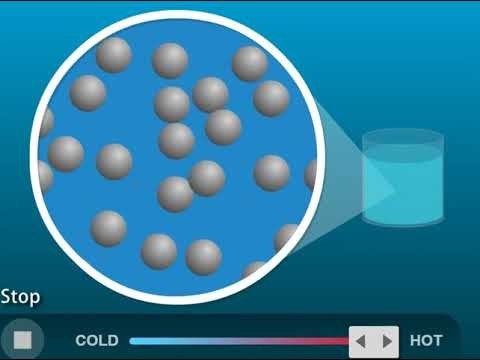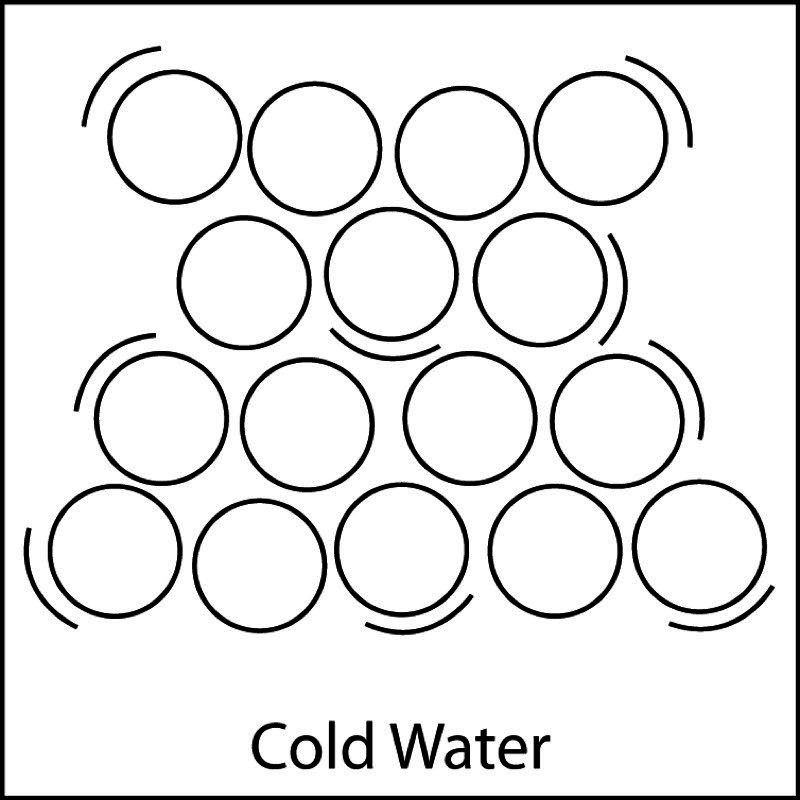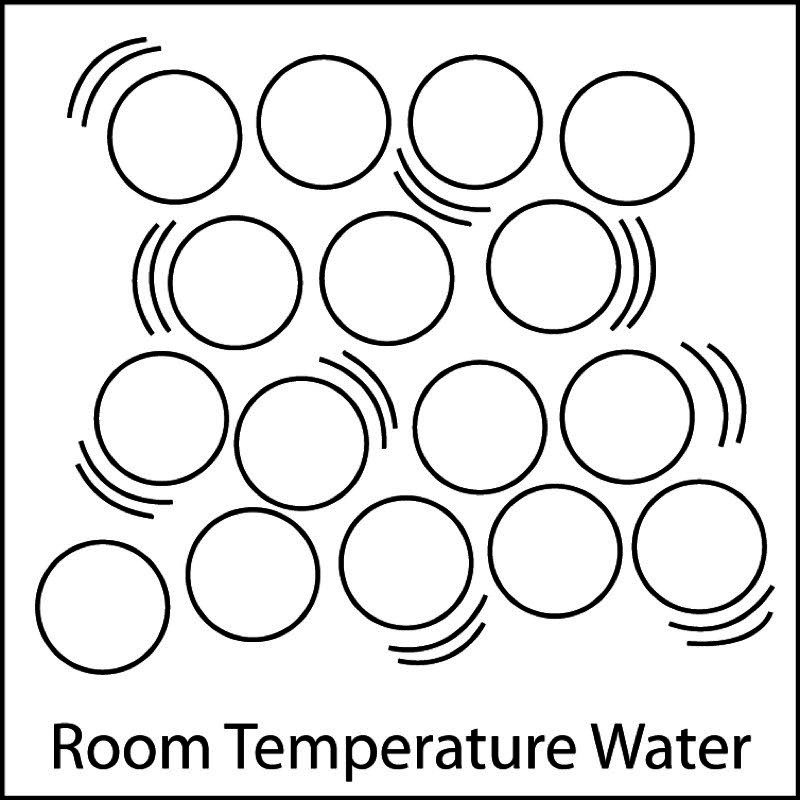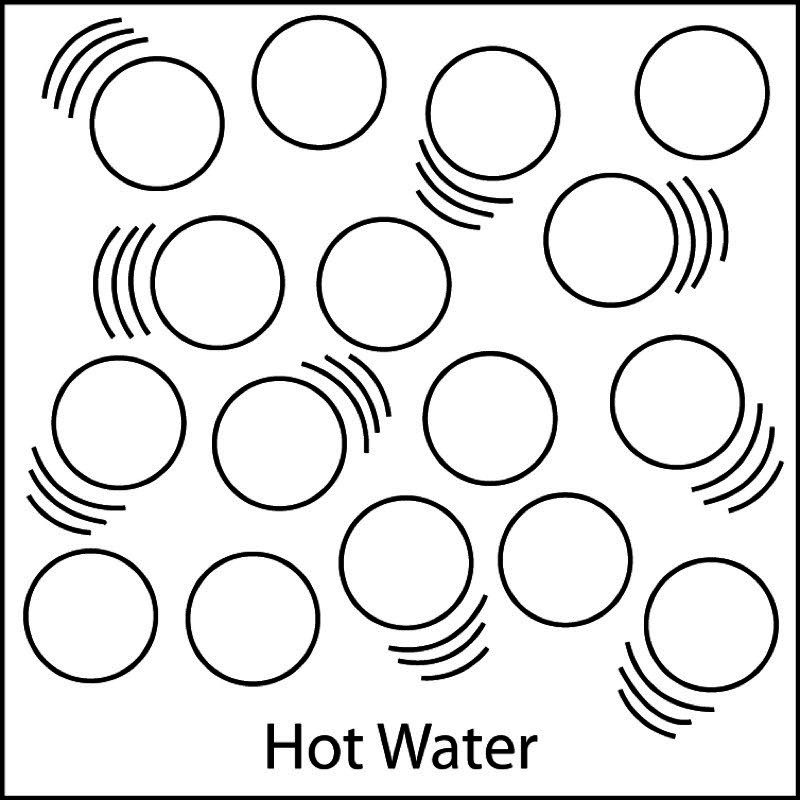Molecules in Motion
Lesson Summary Video for teachers
Note: This video is designed to help the teacher better understand the lesson and is NOT intended to be shown to students. It includes observations and conclusions that students are meant to make on their own.
Key Concepts
- Heating a liquid increases the speed of the molecules.
- An increase in the speed of the molecules competes with the attraction between molecules and causes molecules to move a little further apart.
- Cooling a liquid decreases the speed of the molecules.
- A decrease in the speed of the molecules allows the attractions between molecules to bring them a little closer together.
Summary
Students add food coloring to hot and cold water to see whether heating or cooling affects the speed of water molecules. Students watch molecular model animations to see the effect of heating and cooling on the molecules of a liquid. Students will also draw their own molecular model.
Objective
Students will be able to explain, on the molecular level, that heating and cooling affect molecular motion.

Safety
Be sure you and the students wear properly fitting goggles.
Materials for Each Group
- Hot water (about 50 °C) in a clear plastic cup
- Cold water in a clear plastic cup
- Yellow food coloring in a small cup
- Blue food coloring in a small cup
- 4 droppers
Download All Lesson 1.2 Resources
Get the entire lesson plan and Student Activity Sheet for "Lesson 1.2: Molecules in Motion."
Online Assignments
Supplement in-class learning with interactive, multimedia-rich Google Forms lesson modules, perfect for reinforcing key chemistry concepts and scientific investigation skills.
Instructions
1 Engage
Step 1
Ask students to help you design an experiment to see if the speed of water molecules is different in hot water compared to cold water.
Ask students questions such as the following:
- Is the speed of water molecules different in hot and cold water? What can we do to find out?
Students may guess that molecules in hot water move faster. There are several possible experiments that students might suggest to find out if this is true. One of the more obvious ones is to heat water a lot so that it boils. Then you can see the water moving. You could do that, but it requires a hot plate, takes a fair amount of time, and may have to be done as a demonstration instead of being an activity the students can do.
Tell students that one possible method is to use hot water and cold water and add food coloring to the water. If the water molecules move faster at one temperature than another, the food coloring should move faster too and make the movement easy to see.
Ask students:
- Should we use the same amount of hot and cold water in our experiment?
Yes - Should we use the same type of cup for the hot and cold water?
Yes - Should we use the same number of drops of food coloring in each cup
Yes - Should we put the coloring in at the same time?
Yes
Explain that the different things like the amount of water, type of cup, and number of drops of food coloring are called variables. It is important to keep all the variables the same except for the one you are testing. Because we are trying to find out if temperature affects the motion of water molecules, we should keep everything else about the experiment the same. Temperature should be the only variable. This way, if we notice something different between the two samples of water, we will know that the difference in temperature is causing it.
2 Evaluate
Give each student an activity sheet.
- Lesson 1.2 Student Activity Sheet PDF | DOCX | Google Doc
- Lesson 1.2 Activity Sheet Answers PDF | DOCX | Google Doc
Download the student activity sheet, and distribute one per student.
The activity sheet will serve as the “Evaluate” component of each 5-E lesson plan. The activity sheets are formative assessments of student progress and understanding. A more formal summative assessment is included at the end of each chapter.
Students will record their observations and answer questions about the activity on the activity sheet. The Explain It with Atoms & Molecules and Take It Further sections of the activity sheet will either be completed as a class, in groups, or individually depending on your instructions. Look at the teacher version of the activity sheet to find the questions and answers.
3 Explore
Step 2
Do an activity to compare the speed of water molecules in hot and cold water.
Question to investigate
Is the speed of water molecules different in hot and cold water?
Teacher preparation
- This activity works best if there is a big difference between the temperatures of the hot and cold water.
- Squirt 4–5 drops of blue food coloring into a small cup for each group.
- Squirt 4–5 drops of yellow food coloring into another small cup for each group.
- Add ice to about 6 cups of tap water to make it sufficiently cold.
- Pour about ¾ cup of cold water (no ice) into a cup for each group.
- Pour about ¾ cup of hot water into a cup for each group.
Materials for each group
- Hot water (about 50 °C) in a clear plastic cup
- Cold water in a clear plastic cup
- Yellow food coloring in a small cup
- Blue food coloring in a small cup
- 4 droppers
Procedure
- With the help of your partners, use droppers to carefully place 1 drop of yellow and 1 drop of blue food coloring into the hot and cold water at the same time.
- Allow the colors to mix on their own as you watch them for a couple of minutes.
Step 3
Record and discuss student observations.
Give students time after the activity to record their observations by answering the following questions on their activity sheet. Once they have answered the questions, discuss their observations as a whole group.
- Describe what the colors looked like and how they moved and mixed in the cold water.
- Describe what the colors looked like and how they moved and mixed in the hot water.
- What does the speed of the mixing colors tell you about the speed of the molecules in hot and cold water?
Expected results
The yellow and blue food coloring will spread faster in hot water than in cold. The colors will combine and turn green in the hot water while the colors will remain separate longer in the cold water. Students should agree that the colors mix faster in the hot water because the molecules of both the water and food coloring move faster in hot water than they do in cold water.
4 Explain
Step 4
Show an animation of water molecules at different temperatures.
Show the molecular model animation Heating and Cooling a Liquid.
Move the slider at the bottom of the window all the way to the right to show that the water molecules are moving faster and are a little farther apart in hot water.
Explain that the little balls represent the particles of a liquid, in this case water molecules. Let students know that for now, they will use circles or spheres to represent atoms and molecules, but eventually they will use a more detailed model. For now, students should focus on the motion of the molecules, how they interact, and their distance from one another.
Ask students:
- Are the molecules moving faster in cold or hot water?
Students should realize that the molecules of hot water are moving faster. The molecules of cold water are moving slower. - How does this match with your observations with the food coloring?
The food coloring in the hot water mixed faster than the coloring in the cold water did. - Look closely at the space between the molecules in cold and hot water. Is there more space in between the molecules in hot water or in cold water? Is it a lot of space?
Point out to students that molecules of hot water are moving faster and are slightly further apart. The molecules of cold water are moving slower and are a little closer together. If students do not notice a difference, move the slider all the way to the left again and then quickly to the right. Show the animation a few times to give students a chance to notice the differences.
Step 5
Have students answer questions about the animation and draw a model of water molecules on their activity sheet.
Have students fill in the blank with the word increases or decreases on their activity sheet as you read each sentence.
- Heating a substance increases molecular motion.
- Cooling a substance decreases molecular motion.
- As molecular motion increases, the space between molecules increases.
- As molecular motion decreases, the space between molecules decreases.
Project the image Water Molecules at Different Temperatures.
Have students refer to the drawing of room temperature water on their activity sheet and discuss how they should represent the molecules in cold and hot water.
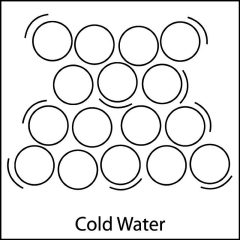
Cold water
Ask students:
- Would the water molecules be closer together or further apart?
Students should draw the circles a little closer together than the circles in the room temperature water. The water molecules are closer together because the slower motion allows the attractions to bring the molecules a little closer together. - Would there be more or fewer motion lines?
Students should realize that since the molecules in the cold water are moving slower, they should have fewer motion lines than the molecules in room temperature water.
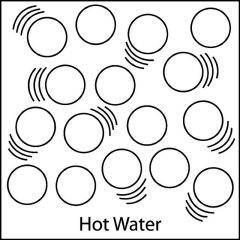
Hot water
Ask students:
- Would the water molecules be closer together or further apart?
Students should draw the circles a little further apart than the circles in the room temperature water. The faster motion competes with the attractions water molecules have for each other and causes the molecules to move a little further apart. - Would there be more or fewer motion lines?
Students should realize that since the molecules in hot water are moving faster than in cold or room temperature water, they should draw more motion lines.
5 Extend
Step 6
Have students explain why hot water takes up more space than room temperature water.
Have students read and discuss the Take It Further question on the activity sheet. After the class discussion, have students write their own response to the following question in the space provided on the activity sheet.
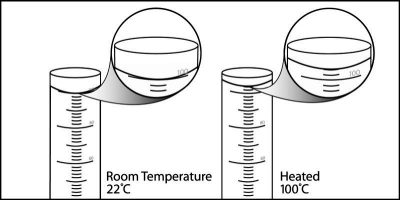
- Let’s say that you measure exactly 100 milliliters of water in a graduated cylinder. You heat the water to 100 °C and notice that the volume increases to 104 milliliters. Using what you know about the attractions between water molecules and the way heating affects molecular motion, explain why the volume of water in the cylinder increases when it is heated.
Students should realize that the molecules in hot water move slightly further apart, accounting for the increased volume.
What is the 5-E format?
The 5-E instructional model is an approach to teaching and learning that focuses on active engagement, inquiry-based learning, and collaboration.
Downloads
For Students
- Lesson 1.2 Student Activity Sheet PDF | DOCX | Google Doc
For Teachers
- Lesson 1.2 Lesson Plan PDF | DOCX | Google Doc
- Lesson 1.2 Activity Sheet Answers PDF | DOCX | Google Doc
Resources for the entire Chapter 1
- Chapter 1 Student Reading PDF | DOCX | Google Doc
- Chapter 1 Test Bank PDF | DOCX | Google Doc
Interactive Lesson Modules
- Lesson 1.2 Online Assignments Google Form
Have Questions? Visit Help Center
